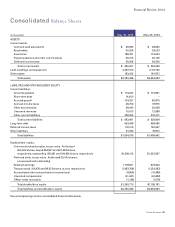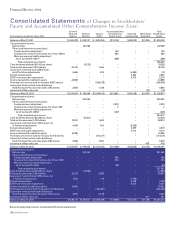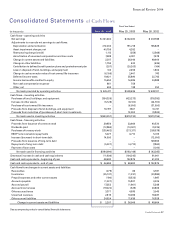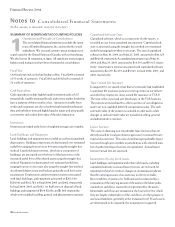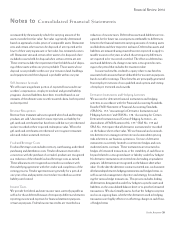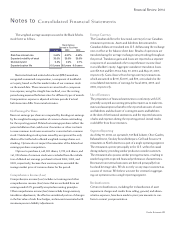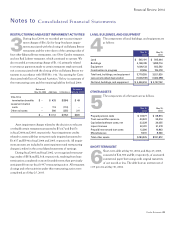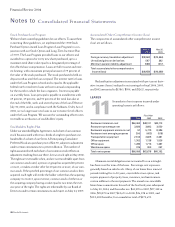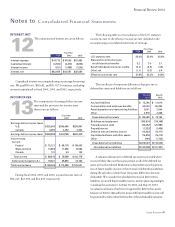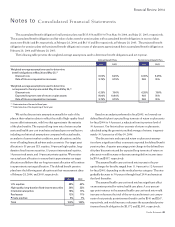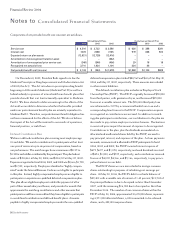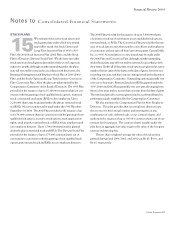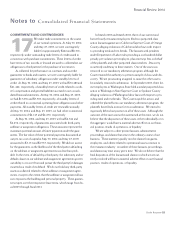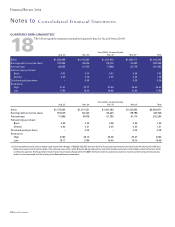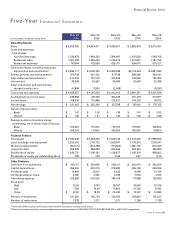Red Lobster 2004 Annual Report Download - page 45
Download and view the complete annual report
Please find page 45 of the 2004 Red Lobster annual report below. You can navigate through the pages in the report by either clicking on the pages listed below, or by using the keyword search tool below to find specific information within the annual report.Notesto
Consolidated Financial Statements
reported as other comprehensive income. These changes in fair
value are subsequently reclassified into earnings when the natural
gas and coffee are purchased and used by us in our operations.
Net gains (losses) of $(439) and $941 related to these derivatives
were recognized in earnings during fiscal 2004 and 2003, respec-
tively. The fair value of these contracts was a net gain of $106 at
May 30, 2004, and is expected to be reclassified from accumulated
other comprehensive income (loss) into food and beverage costs
or restaurant expenses during the next 12 months. To the extent
these derivatives are not effective, changes in their fair value are
immediately recognized in current earnings. Outstanding deriva-
tives are included in other current assets or other current liabilities.
At May 30, 2004, the maximum length of time over which we
are hedging our exposure to the variability in future natural gas cash
flows is 12 months. At May 30, 2004, we are not hedging our expo-
sure to the variability in future coffee cash flows. No gains or losses
were reclassified into earnings during fiscal 2004 or 2003 as a result
of the discontinuance of natural gas and coffee cash flow hedges.
Interest Rate Lock Agreement
During fiscal 2002, we entered into a treasury interest rate lock
agreement (treasury lock) to hedge the risk that the cost of a future
issuance of fixed-rate debt may be adversely affected by interest rate
fluctuations. The treasury lock, which had a $75,000 notional prin-
cipal amount of indebtedness, was used to hedge a portion of the
interest payments associated with $150,000 of debt subsequently
issued in March 2002. The treasury lock was settled at the time of
the related debt issuance with a net gain of $267 being recognized
in other comprehensive income. The net gain on the treasury lock is
being amortized into earnings as an adjustment to interest expense
over the same period in which the related interest costs on the new
debt issuance are being recognized in earnings. Amortization of
$53, $53, and $14 was recognized in earnings as an adjustment to
interest expense during fiscal 2004, 2003, and 2002, respectively.
It is expected that $53 of this gain will be recognized in earnings as
an adjustment to interest expense during the next 12 months.
Interest Rate Swaps
During fiscal 2004, we entered into interest rate swap agreements
(swaps) to hedge the risk of changes in interest rates on the cost of a
future issuance of fixed-rate debt. The swaps, which have a $75,000
notional principal amount of indebtedness, will be used to hedge a
portion of the interest payments associated with a forecasted issuance
of debt in fiscal 2006. To the extent the swaps are effective in offset-
ting the variability of the hedged cash flows, changes in the fair value
of the swaps are not included in current earnings but are reported as
other comprehensive income. The accumulated gain or loss at the
swap settlement date will be amortized into earnings as an adjustment
to interest expense over the same period in which the related interest
costs on the new debt issuance are recognized in earnings. The fair
value of the swaps at May 30, 2004 was a gain of $698 and is included
in accumulated other comprehensive income (loss) at May 30, 2004.
No amounts were recognized in earnings during fiscal 2004.
We had interest rate swaps with a notional amount of $200,000,
which we used to convert variable rates on our long-term debt to
fixed rates effective May 30, 1995. We received the one-month
commercial paper interest rate and paid fixed-rate interest ranging
from 7.51 percent to 7.89 percent. The interest rate swaps were
settled during January 1996 at a cost to us of $27,670. This cost
is being recognized as an adjustment to interest expense over the
term of our 10-year, 6.375 percent notes and 20-year, 7.125 percent
debentures (see Note 7).
FINANCIALINSTRUMENTS
9The fair values of cash equivalents, accounts receivable,
accounts payable, and short-term debt approximate
their carrying amounts due to their short duration.
The carrying value and fair value of long-term debt
at May 30, 2004, was $653,349 and $700,383, respectively. The
carrying value and fair value of long-term debt at May 25, 2003,
was $658,086 and $740,130, respectively. The fair value of long-
term debt is determined based on market prices or, if market prices
are not available, the present value of the underlying cash flows
discounted at our incremental borrowing rates.
STOCKHOLDERS’EQUITY
10Treasury Stock
Our Board of Directors has authorized us to
repurchase up to 115.4 million shares of our
common stock. In fiscal 2004, 2003, and
2002, we purchased treasury stock totaling $235,462, $213,311,
and $208,578, respectively. At May 30, 2004, a total of 109.2
million shares have been repurchased under the authorization.
The repurchased common stock is reflected as a reduction of
stockholders’ equity.
45
Financial Review 2004


